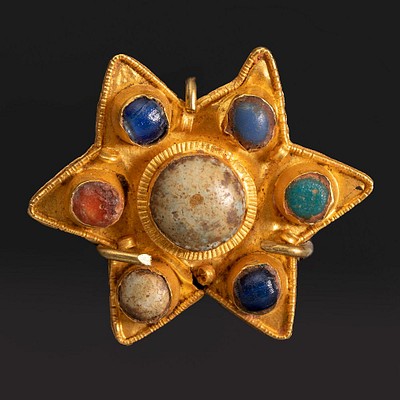Spanish school; ca. 1840. "Imposition of merits of Isabella the Catholic to Gonzalo Fernandez de Cordoba". Oil on canvas.
Lot 108
About Seller
Setdart Auction House
Carrer Aragó 346
Barcelona
Spain
Setdart Subastas was born in 2004 and is currently the first online art auction in Spain with solidity, prestige and reliability guaranteed by our more than 60,000 users. Setdart has a young, dynamic and enterprising team ready to successfully manage the purchase and sale of art works through custom...Read more
Estimate:
EUR€8,000 - EUR€9,000
$8,602.15 - $9,677.42
Absentee vs Live bid
Two ways to bid:
- Leave a max absentee bid and the platform will bid on your behalf up to your maximum bid during the live auction.
- Bid live during the auction and your bids will be submitted real-time to the auctioneer.
Bid Increments
| Price | Bid Increment |
|---|---|
| EUR€0 | EUR€10 |
| EUR€200 | EUR€25 |
| EUR€500 | EUR€50 |
| EUR€1,000 | EUR€100 |
| EUR€3,000 | EUR€200 |
| EUR€5,000 | EUR€500 |
| EUR€10,000 | EUR€1,000 |
| EUR€20,000 | EUR€2,000 |
| EUR€50,000 | EUR€5,000 |
About Auction
By Setdart Auction House
Dec 21, 2021
Set Reminder
2021-12-21 07:30:00
2021-12-21 07:30:00
America/New_York
Bidsquare
Bidsquare : Córdoba: 2,000 Years of Art
https://www.bidsquare.com/auctions/setdart-auction-house/c-rdoba-2-000-years-of-art-8049
Setdart Auction House sofia@setdart.com
Setdart Auction House sofia@setdart.com
- Lot Description
Spanish school; ca. 1840. "Imposition of merits of Isabella the Catholic to Gonzalo Fernandez de Cordoba". Oil on canvas. It has repainting and xylophagous remains on the frame. Measurements: 142 x 187 cm; 154 x 200 cm (frame). In this work of landscape format is represented the historical moment in which Isabel the Catholic recognizes the merits of the military Gonzalo Fernandez de Cordoba. It is probable that it is the exact moment in which he is named Viceroy of Naples, since the personage that is next to the queen in the center of the composition, Don Gonzalo, carries on his head a shining crown. Compositionally the work follows a structure that tries to favor at all times the narrative capacity of the work. To this end, the author arranges the protagonists of the scene in the center, while the rest of the characters are arranged on the sides, in such a way that they form a curved and concave line, leaving a space in the central area of the foreground, which allows the viewer to participate as one more, entering the scene. Gonzalo Fernandez de Cordoba, was a recognized Castilian nobleman and military man, who achieved great military merits that earned him the nickname of "The Great Captain", he was also a commander of the Order of Santiago, whose importance is reflected in this work. Gonzalo and his older brother Alfonso Fernández de Córdoba grew up in Córdoba under the care of Pedro de Cárcamo. As a child he was incorporated as a page in the service of Prince Alfonso of Castile, brother of Queen Isabella I of Castile, and upon his death, he joined the retinue of Princess Isabella. The "Great Captain" was a pioneer of modern warfare. He revolutionized 16th century military strategy by integrating firearms into the Spanish infantry and led the first battle in history to be won with small powder weapons. He helped found the first modern standing army and pioneered combined arms warfare by combining the use of infantry, cavalry and artillery with naval support. The historical theme of the painting is set in a glorious past related to the history of the painter's country, Spain. This theme can be related to the pictorial historicism current developed during the 19th century, the main current at the time, linked to the Academies of Fine Arts. The term "historicism" (Historismus) was coined by the German philosopher Karl Wilhelm Friedrich Schlegel. Over time, what historicism is and how it is practiced has taken on different and divergent meanings. Elements of historicism appear in the writings of French essayist Michel de Montaigne (1533-1592) and Italian philosopher GB Vico (1668-1744), and were more fully developed with the dialectics of Georg Wilhelm Friedrich Hegel (1770-1831), influential in 19th-century Europe.
- Shipping Info
-
In-house shipping available. Please inquire at admin@setdart.com.
-
- Buyer's Premium



 EUR
EUR CAD
CAD AUD
AUD GBP
GBP MXN
MXN HKD
HKD CNY
CNY MYR
MYR SEK
SEK SGD
SGD CHF
CHF THB
THB
















